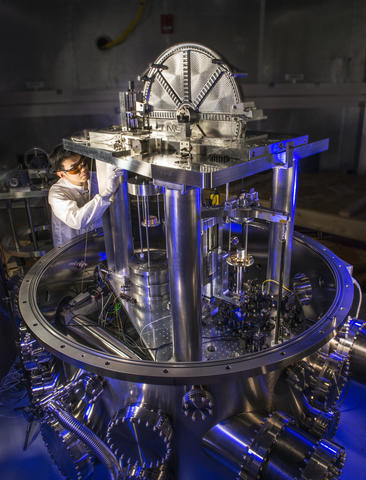Universe’s Constants Now Known with Sufficient Certainty to Completely Redefine the International System of Units

Through its measurements of Planck’s constant, a quantity at the heart of quantum physics, the NIST-4 watt balance is contributing to an international effort to define all base measurement units in terms of fundamental constants of nature.
Fundamental constants are physical quantities that are universal in nature. For example, the speed of light in vacuum and the charge of a single electron are the same everywhere in the universe. That is why scientists would like to use invariant quantities of nature to define the seven base measurement units of the International System of Units (SI), or the modern metric system, rather than to rely on measurements of physical artifacts.
According to a recent evaluation and update of the values of the fundamental constants by researchers at the National Institute of Standards and Technology (NIST), the uncertainties in measurements of the constants have now been reduced to such exceedingly low levels that all of the SI units can now be linked to them.
This new and redefined SI will benefit science, technology, industry and commerce by helping to ensure the long-term stability of these base units and the entire international measurement system.
The latest update of the values of the fundamental constants was authored by NIST’s Peter Mohr, David Newell and Barry Taylor, who lead the international Task Group on Fundamental Constants of the Committee on Data for Science and Technology (CODATA). This task group updates the values every four years. The new quantities represent the latest comprehensive adjustment of values of the constants. In the summer of 2017, the task group will perform a special update to produce the final values for four fundamental constants to be adopted in the fall of 2018 by an international body known as the General Conference on Weights and Measures (Conférence Générale des Poids et Mesures, or CGPM).
The seven base units in the SI are the meter, kilogram, second, ampere (a measure of electric current), kelvin (a measure of temperature), mole (a measure of the amount of a substance) and candela (a measure of luminous intensity). The goal of the new SI is to define all of these units completely in terms of fundamental constants with exact values. Some constants, such as the speed of light, are currently defined in this way, as exact quantities.
Examples of fundamental constants range from the magnitude of the elementary charge of a single electron or proton to the extraordinary number of particles in one mole of a substance, described by the Avogadro constant. Another example is the Planck constant, a quantity at the heart of quantum physics that will be used to redefine the kilogram as an invariant property of nature instead of a standard platinum-iridium cylinder.
The evaluation and update reduce the uncertainties in both the Planck and Avogadro constants by almost four times compared to the previous evaluation, to just 12 parts per billion. These uncertainties decreased by reconciling measurements in different “watt-balance” devices around the world and new highly accurate X-ray measurements of a softball-sized sphere of silicon that is a nearly perfect crystal and is made almost entirely of the same isotope of silicon (99.9995 percent silicon-28). The update reduces the relative uncertainty by almost two times, to 0.6 parts per million, for the Boltzmann constant, which can be used to determine the amount of energy in a gas at a certain temperature.
“The reduced uncertainties in these four fundamental physical constants are very significant,” said NIST chemist Donald Burgess, co-editor of the Journal of Physical and Chemical Reference Data (JPCRD). “These now ultra-small uncertainties in the constants will allow the CGPM to revise the International System of Units so that the seven base units will be exactly defined in terms of fundamental constants. In turn, many equations that describe the laws of nature—such as the relationship between energy and temperature as expressed through Boltzmann’s constant—will now be exact and not depend on measurement units that have inherent uncertainties because of the way that they are currently defined.”
This update of the fundamental physical constants is appearing in both the JPCRD (published by the American Institute of Physics) and the Reviews of Modern Physics (published by the American Physical Society). The JPCRD came into existence as a consequence of an act of Congress, the Standard Reference Data Act of 1968 (Public Law 90-396), which gave NIST the primary responsibility in the federal government to make critically evaluated scientific and technical reference data available to scientists, engineers and the general public.

